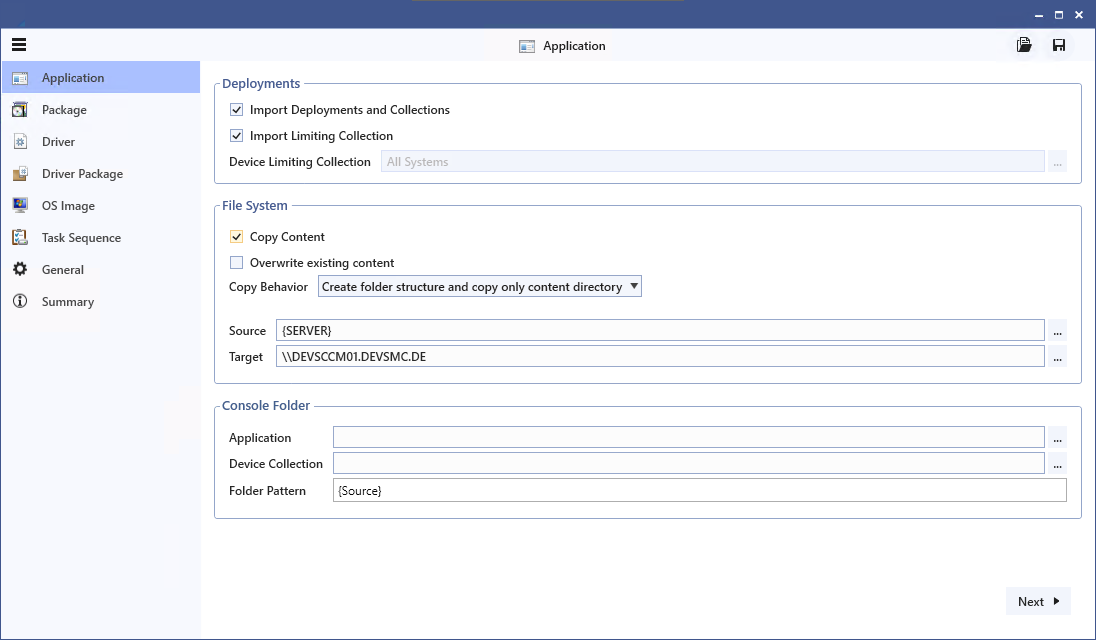Change log
DieThe folgendefollowing Übersichtoverview beschreibtdescribes neuenew Featuresfeatures undand Fehlerkorrekturenbug desfixes of the SCCM Teleporters. Teleporter.
Green Notes: New Feature
Yellow Notes: Note
Red Notes: Bug fixed
Version 1.6.3.0 (2022-07-08)
Support for long file paths (> 256 characters).
When importing applications, the Owner field can be reset.
Version 1.6.2.0 (2022-05-16)
When importing packages from tp1 files, file paths could not be resolved correctly.
Version 1.6.1.0 (2022-03-23)
After teleporting Applications / Packages, the corresponding collections cannot be accessed with Application Manager 2.7.4.
Version 1.6.0.0 (2022-03-01)
Release Version 1.6
TP1 files created with version 1.6 are not compatible with other versions.
Version 1.5.2.0 (2021-12-01)
Application: If supersedence references are available, the selection can be made in the import dialog as to whether these references are to be imported and assigned or whether the application is to be imported without supersedence references.
Application: Support for Repair Deployment added.
Transfer Objects, Copy Content: Dots in the name of a folder within a file path lead to incorrect resolution of file paths. If folders contain dots in their names, the Copy Content function cannot be used and a rollback at the file system level cannot be performed.
Read Site Server contents: Saved filters of the type SCCM Parent Folder, SCCM Category and Last Modified contain incorrect values when loading a saved filter configuration.
Version 1.5.1.19 (2021-11-03)
Support of the import of supersedence references for applications.
Application: After importing an application with supersedence references, these continued to refer to objects in the source environment.
Version 1.5.1.18 (2021-10-01)
Release Candidate Version 1.5
tp1 files created with version 1.4 are not compatible with this version.
Revision of the import dialog: Added dynamic indication of the source and intelligent replacement of file paths.
Added dynamic indication of the source and intelligent replacement of file paths.
The source system can be specified via the placeholder {Server}.
Source paths can be specified as patterns: \(Software)(Applications)
Support of the  Nested task sequences object type
Nested task sequences object type
Full support of user collection  and device collection
and device collection  object types.
object types.
Collections can be transferred as an independent object.
The creation of used include, exclude and query membership rules is granularly configurable.
Limiting collections are now evaluated by default for collections.
During import, these can be created automatically, existing collections can be referenced and used if they have the same name, or optionally an existing collection can be assigned as the new limiting collection.
Support of the  Query object type
Query object type
Support of the  Status Message Query object type
Status Message Query object type
Attachment console folder structure
When using the {Source} placeholder, the folder structure of the source environment is restored for an object.
Version 1.4.0.0 (2020-06-02)
Release Version 1.4
Minor bug fixes
Version 1.3.0.0 (2018-08-02)
Support for transfer of SCCM objects between sites in different domains without mutual trust. Reading the package sources in the source system and writing them in the target system is now done in the user context of the user account used for the SCCM connection.
Version 1.2.1.3 (2018-02-02)
Import SCCM objects from a SCCM Teleporter tp1 file: In a few cases with overlapping paths in the file system, these paths were not interpreted correctly and the import process was not completed.
Version 1.2.1.2 (2018-01-02)
Import and export actions can now also be canceled via a button.
Version 1.2.1.1 (2017-12-02)
Import SCCM objects: Status icons added for better evaluation of the import. After the import process, it is thus directly recognizable whether an object could be successfully created, was marked as already existing or could not be imported.
SCCM Objects Import, Summary: Added verification of required file system permissions
Import SCCM objects, summary: display error fixed.
Version 1.2.0.0 (2017-10-02)
Global (mandatory) configuration settings.
Global configurations (import and/or export settings) can be stored per SCCM site for the use of the SCCM Teleporter. These configurations can be made available to a user group either as mandatory read only settings, or as recommended default settings.
Import SCCM objects dialog, summary added before performing import. Here appears an overview of all objects and SCCM object dependencies to be imported, the folder structure to be created in the file system, the behavior in case of error and the selected distribution point group.
SCCM Objects Import, Summary: Added verification of required file system permissions